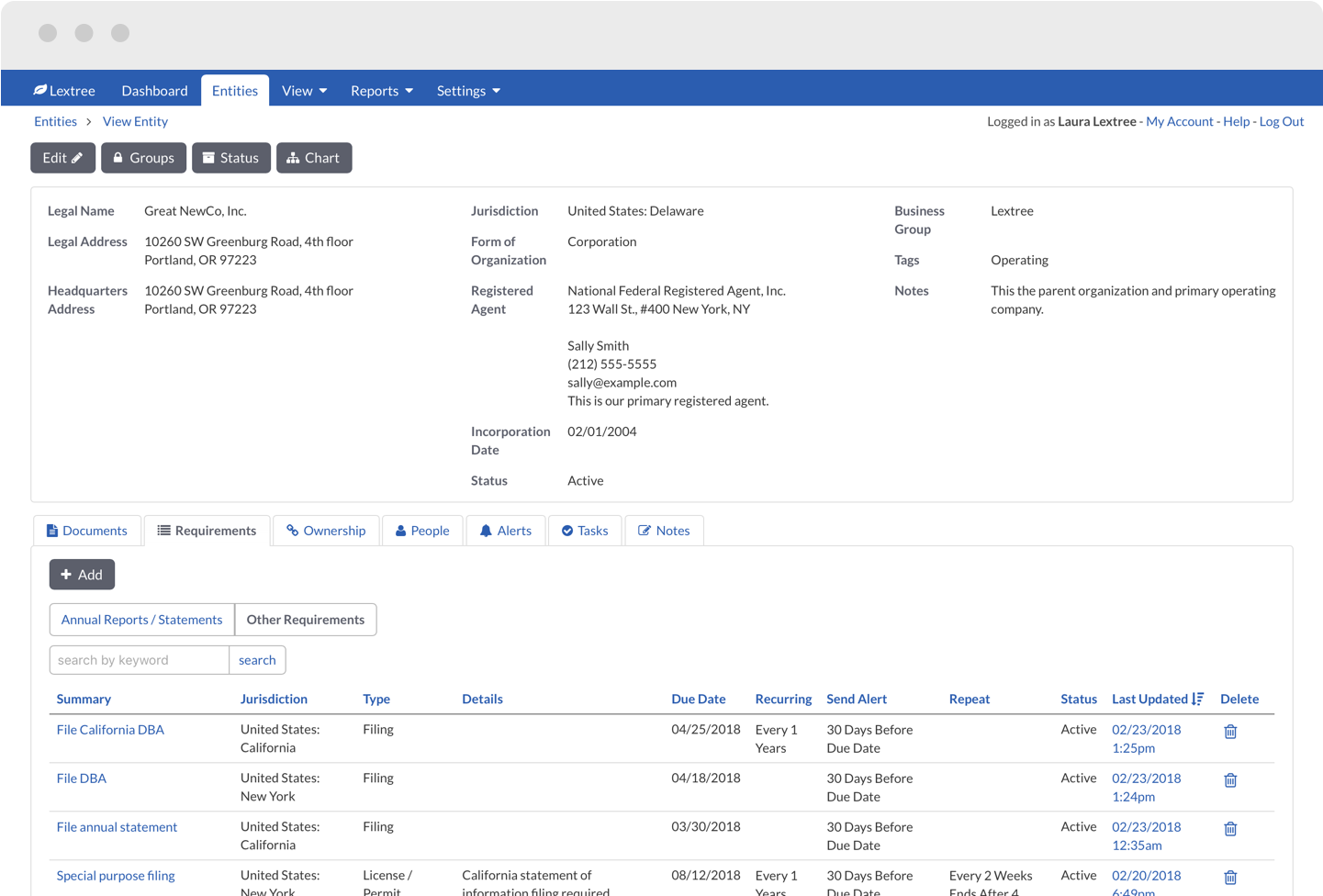Better Global Legal Entity Management
Updated:

Compliance and governance introduce orders of magnitude more risk when businesses operate within a global company structure. Lawyers, compliance officers, and risk managers can take practical steps to manage a portfolio of global legal entities.
Looking for information on global business types? Check out our global business entity guide where you can find legal entities by country and subregion.
5 tips and techniques to reduce risk and improve compliance
Make global entity management better with these five changes:
- Centralize global entity data in one place.
- Implement a process for monitoring filings across jurisdictions.
- Assign officers and directors from a master list.
- Generate company organizational charts regardless of jurisdictions.
- Collaborate based on data, not email.
Centralize global entity data in one place
The first step is a big one for many companies. International organizations create siloed geographic operations. A history of local acquisitions leads a patchwork of legal entities and business operations by geography. There are also business and tax motivations for creating high walls between parts of the corporate structure.
The proliferation of legal entities in a global context, however, magnifies the need for a single registry for every legal entity. That is the only way for the General Counsel’s office to have visibility into the entire structure.
Collect global entity data in one place
Centralizing global entity data requires gathering up all the spreadsheets, or other data sources, from each business and jurisdiction. It is usual for organizations even with surprisingly large operations to manage legal entities from a spreadsheet.
Even if there is a system in place, it is deployed for some legal entities and does not provide the full picture of the corporate family.
Inventory and harmonize global entity data
Once you have all the data sources or spreadsheets, it is important to identify the types of data in each set. The data itself is not important at this phase. Sample data illustrates the data types.
For example, data about officers and directors1 might be labelled differently but the information is essentially the same. What one spreadsheet calls a “mandate” might be “term of service” on another.
When examining legal entity data from different spreadsheets or applications, ask yourself these questions about each column or data:
- Is this the same type of information with different labels or are they genuinely distinct?
- Are there columns or types of data about legal entities in one spreadsheet which are entirely absent from another?
- Does this information matter or we just collecting it?
These questions will help you harmonize column-by-column across spreadsheets to produce better legal entity data. Now, data is ready to get moved to a single spreadsheet, which can house entity data for any jurisdiction.
Convert standardized data to global entity management database
Once your global entity data is standardized on a single spreadsheet, you should convert it to a database application. Spreadsheets are useful for lists and calculations, but they are not effective as long-term storage of critical corporate data.
When it comes to international legal entity data, there are two particular shortcomings of spreadsheets. First, they are cumbersome for tracking many items related to the main legal entities. For example, you have a Canadian corporation with filings in each Canadian province. The spreadsheet has to have a lot of duplicate data in order to capture those filings for the Canadian corporation, and then every other entity in the corporate family.
Second, data-driven entity management can generate automatic notifications which are essential to achieve the compliance benefits of global entity management.
There are several options for entity management applications. Moving away from spreadsheets toward data-centric solutions is critical.
Implement a process for monitoring filings across jurisdictions
Jurisdiction management is critical for global businesses. What does “jurisdiction management” mean? Jurisdiction management means thinking about jurisdictions conceptually to improve compliance and reporting.
There are three broad types of jurisdictional structures for entity management:
- National systems, such as Switzerland, Luxembourg, Singapore, and the United Kingdom2, where companies are formed and filed with the national authority;
- Regional, state, or provincial systems, such as the United States, where companies are formed and filed with subnational jurisdictions; and
- Hybrid systems, like Canada and Australia, where incorporators choose between national and provincial or state registration.
Why does this matter? When you move to an entity management system, it needs to accommodate every type of jurisdiction as part of your global compliance program.
You can run reports on all filings for entities “in the United States” or just in the states of Delaware, New York, and California.
Jurisdictional data is used for the place of incorporation and for a variety of filings. For example, a Delaware corporation might file for a Foreign Authorization in New York, Connecticut, and California.
The entity management system should easily handle all those jurisdictions within the context of the Delaware corporation.
A data-driven system delivers several additional benefits related to jurisdictions:
- Tracking filing obligations beyond annual reports or statements.
- Linking documents to particular jurisdictions.
- Reporting on compliance obligations across all jurisdictions. For example, see all requirements due in the next 90 days.
Jurisdictional data for global legal entity management is not a burden when it helps reduce risk and improve compliance.
Assign officers and directors from a master list
Global legal entities assign officers and directors to more than one legal entity in the corporate family. Records of those assignments reside physically with the local legal entity.
New approach to managing officers and directors
When you want to know which legal entities to which an officer or director is assigned, there is a time-consuming process to request and review documents for the likely entities.
That process is error prone because it might not capture all the relevant entities. Terminology and legal requirements across jurisdictions can complicate the task.
With entity management, however, you develop a master list of people (or other entities) who serve entities in the corporate. You then assign people from that list to a particular entity in a certain role. The roles might vary between entities.3 For example:
| Name | Legal Entity | Role |
|---|---|---|
| Sally Jones | Global Enterprise, Inc. | Director |
| Sally Jones | Regional Firm, LLC | Treasurer and CFO |
| Sally Jones | Local Co., Inc. | President |
This approach to assigning officers and directors means that you can create reports organized by person in minutes rather than hours or days.
Terms of service for officers and directors
With officers and directors assigned to multiple entities, you want to track when their mandates start and stop. Tracking mandates, or terms of service, allows you to know who was on the board of directors during a particular year when an important decision was made.
Generate company organizational charts regardless of jurisdictions
Consolidating all legal entity data for a global company allows you to generate organizational charts showing ownership regardless of those jurisdictions.
Catchy do not draw organizational charts by hand or with a drawing tool. These org charts are chock-full of errors and quickly become outdated.
Manually drawn org charts catch also do not keep the generational hierarchy intact. Generation skipping is the idea that an entity can own another one both directly and indirectly. Indirect ownership requires that the parent be placed two levels above the original entity to accommodate the intervening indirect ownership.
In a large ownership chart, maintaining generational hierarchy can be difficult with manual drawing. This is a place where automated company org charts are far superior to hand-drawn charts.
Collaborate based on data, not email
The transition from a collection of spreadsheets to data-driven entity management also allows cross-border legal teams to collaborate intelligently, rather than through email.
Here are just a few practical examples of improved collaboration:
A New York based lawyer assigns trade filing task to her colleagues in Texas and Mexico. All three now have a point of collaboration to share documents and mark as task as complete.
A system automatically notifies legal counsel in three different states of impending foreign authorization filings.
Legal team enables the head of an international division to view important data about the legal entities under management, while limiting the ability of that manager to make changes.
Global entity management is a powerful way for in house legal teams to become more effective at reducing risk and improving compliance. ↩︎
Here, officers and directors includes similar roles for other types of legal entities, like limited liability companies, and partnerships. ↩︎
